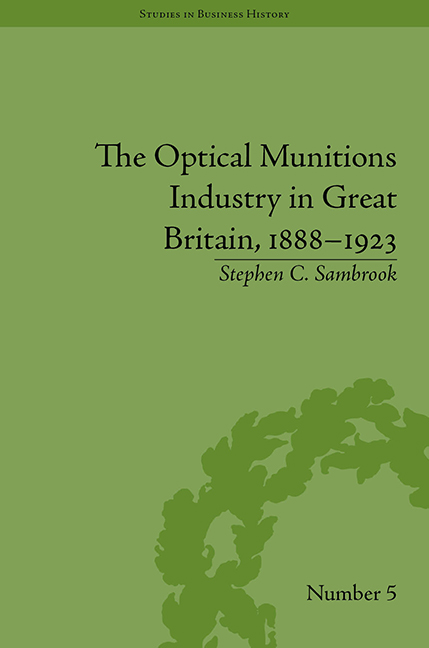Book contents
- Frontmatter
- CONTENTS
- Preface and Acknowledgements
- List of Figures and Tables
- List of Technical Terms
- Introduction
- 1 The Emergence of the Industry, 1888–99
- 2 The Growth in Importance from the Boer War to 1906
- 3 Expansion and Consolidation, 1907–14
- 4 The Impact of War, August 1914 to mid-1915
- 5 Industrial Mobilization: The Ministry of Munitions and its Relationship with the Industry
- 6 The Industry's Wartime, 1915–18
- 7 Industrial Demobilization and Implosion, 1919
- 8 Adaption and Survival, 1919–23
- Conclusion
- Notes
- Works Cited
- Index
2 - The Growth in Importance from the Boer War to 1906
- Frontmatter
- CONTENTS
- Preface and Acknowledgements
- List of Figures and Tables
- List of Technical Terms
- Introduction
- 1 The Emergence of the Industry, 1888–99
- 2 The Growth in Importance from the Boer War to 1906
- 3 Expansion and Consolidation, 1907–14
- 4 The Impact of War, August 1914 to mid-1915
- 5 Industrial Mobilization: The Ministry of Munitions and its Relationship with the Industry
- 6 The Industry's Wartime, 1915–18
- 7 Industrial Demobilization and Implosion, 1919
- 8 Adaption and Survival, 1919–23
- Conclusion
- Notes
- Works Cited
- Index
Summary
Before the start of the Second Boer War in 1899, the optical instruments employed by the British armed forces had yet to be used on active service in a major war. Although the British Army had been involved in fighting in colonial campaigns throughout the second half of the century, there had been no sustained experience of action to demonstrate the effectiveness of the equipment combined with the tactics into which they fitted or, equally importantly, the ability of the domestic industry to manufacture when faced with the increases in demand typified by large-scale and sustained warfare. By the end of 1906 the British Army had been able to digest how efficiently its optical munitions performed in the Boer War and the War Office had had the opportunity to consider how well its procurement processes had worked. The emergent optical munitions industry had also been given a taste of government contracting under the urgency and pressures of wartime conditions. The Royal Navy had seen no fighting at sea and thus had experienced none of the first-hand experiences of the Army, but it continued to be the industry's more important British service client, its demands increasingly driven by a combination of factors including evolving attitudes to gunnery, improvements in ordnance and the emergence of what amounted to entirely new weapon systems in the form of the submarine and the Dreadnought battleship.
- Type
- Chapter
- Information
- Publisher: Pickering & ChattoFirst published in: 2014



